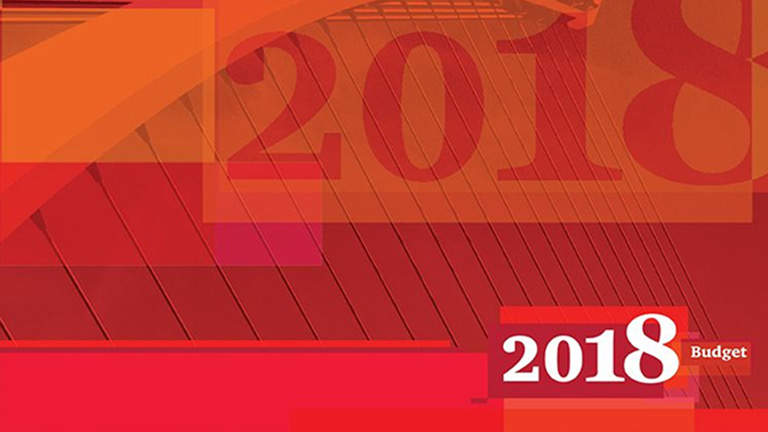A Firstline Securities blog by Mike
On the 10th May 2018 the Minister of Finance of Trinidad and Tobago, Colm Imbert, presented his 2018 Mid-Year Budget Review. In this and the next two blog entries we begin to explore the main contents of that presentation and the implications of the review for the citizens of Trinidad and Tobago.
The 2018 Budget
The 2018 budget was predicated on expenditure of TT$50.5 billion – which included capital expenditure of TT$5.1 billion – and revenue of TT$45.74 billion, leaving a fiscal deficit of TT$4.76 billion representing 3% of Gross Domestic Product (GDP). The fiscal deficit was to be financed through external borrowing (sourced externally from Trinidad and Tobago) of TT$3.69 billion and domestic borrowing of TT$1.07 billion.
The FY 2018 budget was based on price assumptions for oil at US$52 per barrel and gas at US$2.75 per MMBtu. Since the delivery of the 2018 budget, crude oil prices have been strengthening and have averaged US$59 per barrel over the first six months of fiscal year 2018.
At the date of the mid-year review West Texas Intermediate (WTI) prices stood at US$71 per barrel.
Ahead On Collections And Behind On Expenditure
GORTT’s revenue projections for 2018 remain on track. Up to the end of March 2018, TT$19.5 million has been collected against a projected target of TT$18.7 billion.
Expenditure to the end of March 2018 amounted to TT$21.69 billion, almost 15% below targeted expenditure of TT$25.03 billion. The shortfall in expenditure is attributable to reductions in the purchase of goods and services, capital expenditure, transfers and subsidies.
As a result of adjustments to revenue and expenditure estimates for the remainder of FY 2018, the overall deficit for FY 2018 is now estimated at TT$4.2 billion. This is TT$500 million less than originally budgeted. Relative to GDP the revised budget deficit represents 2.5% of GDP compared to 8% in 2017.
Taking improvements in the economy and revisions to budget estimates, as at March 2018 the net public sector debt to GDP ratio stood at 55% a significant reduction from 62% (estimated in 2017).
Net foreign reserves stand at US$8.11 billion representing 9 months of import cover.
The Two Serious Challenges Faced By Trinidad And Tobago
According to the Minister of Finance on assuming office 2 ½ years ago the PNM administration has had to deal with two serious challenges:
- Repairing the damage to Trinidad and Tobago’s fiscal accounts: As a result of the fall in oil and gas prices from US$108 per barrel in 2014 to US$26 per barrel in 2016, and a decline in oil and gas production in Trinidad and Tobago, the Government of the Republic of Trinidad and Tobago (GORTT) has lost TT$20 billion annually in revenue since 2014 from the oil and gas sector.
- Reversing the persistent decline in the economy: According to the Minister of Finance this decline has been self-evident for a number of years.
The Economy Of Trinidad And Tobago
There are signs that both the energy and non-energy sectors are slowly beginning to recover. Early estimates suggest that the Trinidad and Tobago economy will grow by 2% in 2018 and 2.2% in 2019. The GDP figures for 2017 are being revised upwards and GORTT now considers that negative growth in 2017 was closer to 1% rather than the 2.6% originally forecast.
The non-energy sector is projected to break even in 2018 while the non-oil sector is expected to grow by 1.2% in 2019 and 2.9% in 2020.
In 2017 unemployment was on average at 5% compared to 4% in the period 2011-2015.
Increasing Gas Output In The Short Term
According to the Minister, the full impact of the Trinidad Region Onshore Compression Project (TROC) and the Juniper Platform, which came on stream in April 2017 and August 2017 respectively, is now materialising. Production levels are expected to rise from 3.37 billion cubic feet per day in 2017 to:
- 8 billion cubic feet per day in 2018
- 94 billion cubic feet per day in 2019
- 05 billion cubic feet per day in 2020
- 14 billion cubic feet per day in 2021
Increased gas production will be driven by the production of new gas from Shell’s Starfish field expected from the fourth quarter of 2018 and BPTT’s Angelin field from the fourth quarter of 2019.
Increasing Gas Output In The Medium Term
While the BPTT Cassia gas compression project will commence operation in 2020, and Shell expects to begin development drilling in the Dolphin field in the 2nd quarter of 2018 the plans for future field development in Trinidad and Tobago are limited.
BPTT expects to perform exploration drilling in the period 2019-2021 but no future field development is expected before 2023. EOG Resources Inc expects to commence exploration and development drilling in 2019, while Shell expects development work to commence in the Bounty and Endeavour fields in 2022. BHP Billiton development plans for Block 3A don’t commence until 2023.
Despite limited plans to develop new fields in the short term the Minister of Finance is confident that the energy sector will meet the demands of the downstream sector in the short-term. Beyond this, access to additional gas from Venezuela will – according to the Minister – “generate substantial opportunities for strengthening and supporting the economy.”
Collection Of Taxes – The Non-Oil And Gas Sector
GORTT’s projection for the collection of taxes from the non-oil and gas sector to April 2018 was TT$3.8 billion. Against this target collections amounted to TT$4.9 billion representing a surplus over target of TT$1.1 billion.
Collection Of Taxes – The Oil And Gas Sector
The collection of corporation tax from the oil and gas sector moved from TT$1.8 billion in the period October 2016 to April 2017, to TT$2.3 billion in the period October 2017 to April 2018.
Inflation And Price Stability?
According to the Minister, headline inflation dropped to 1.3% by the end of 2017, the lowest level it has reached in a number of years and well below the global average of 3.5% for 2017. The Minister suggests that Trinidad and Tobago’s economic recovery is therefore taking place in an environment of price stability.
Are Increasing Oil Prices A Double-Edged Sword?
Higher oil prices are a double-edged sword since if oil remains around US$70 per barrel, the fuel subsidy (which is being phased out over time) could reach as high as TT$900 million in 2018, not all of which was budgeted for in FY2018.
GORTT is therefore looking to complete its work on an appropriate formula that would allow the price of fuel at the pump to move up and down in tandem with the movement in price of refined fuel products. The new formula is expected to be in place by the end of 2018.



